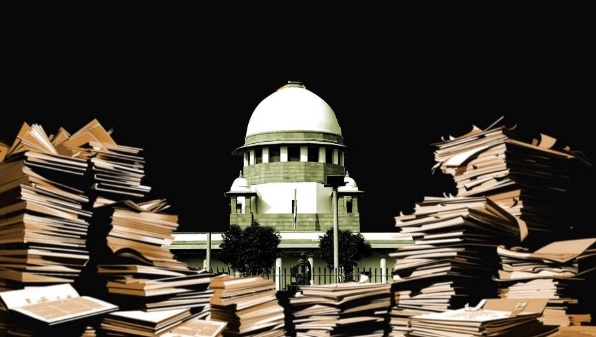India’s judiciary is grappling with an overwhelming backlog of criminal appeals, with over 7.24 lakh cases pending across various High Courts as of March 22, 2025. Recognizing the urgency of the situation, the Supreme Court has unveiled a comprehensive action plan aimed at expediting the resolution of these cases through the integration of artificial intelligence (AI), digitisation, and strategic administrative reforms.
The Magnitude of the Backlog
The Supreme Court, in a suo motu case concerning bail for convicts with prolonged pending appeals, highlighted the staggering number of unresolved criminal appeals. The Allahabad High Court leads with approximately 2.77 lakh pending cases, followed by Madhya Pradesh (1.15 lakh), Punjab and Haryana (79,326), Rajasthan (56,455), and Bombay (28,257). Even smaller states like Chhattisgarh report over 18,000 pending cases.
A significant contributor to this backlog is the acute shortage of judges. For instance, the Allahabad High Court operates with only 79 judges against a sanctioned strength of 160. This deficit hampers the timely adjudication of cases.
Supreme Court’s Strategic Recommendations
To address this crisis, the Supreme Court has proposed a multi-pronged strategy focusing on technological integration and administrative efficiency:
- Digitisation of Trial Court Records
The Court emphasized the need for High Courts to automatically requisition digital copies of trial court records upon the admission of a criminal appeal. This move aims to eliminate delays caused by the manual transmission of documents.
- Appointment of Registrars for Case Management
The creation of the post of Registrar (Court and Case Management) has been recommended to ensure that case files are prepared promptly and all procedural requirements are met before final hearings. This role is pivotal in streamlining case management processes.
- Utilization of AI Tools
The Supreme Court has advocated for the adoption of AI tools, such as SUVAS (Supreme Court Vidhik Anuvaad Software), to facilitate the translation of legal documents. This initiative is expected to expedite the processing of cases by overcoming language barriers and enhancing accessibility.
- Video Conferencing for Inter-Bench Collaboration
High Courts with multiple benches are encouraged to employ video conferencing, enabling benches with lighter caseloads to assist those burdened with heavier workloads. This approach aims to balance the judicial burden and improve case turnover.
- Prioritization of Appeals by Incarcerated Individuals
The Court has underscored the importance of prioritizing appeals filed by individuals currently in custody. This measure seeks to uphold the rights of undertrial prisoners and ensure timely justice.
Call for Expedited Judicial Appointments
Beyond technological interventions, the Supreme Court has categorically underscored that no digital solution can substitute the urgent need to fill judicial vacancies. India’s judiciary continues to operate under-staffed, with several High Courts functioning at half or less than their sanctioned strength.
In a strong rebuke, the Court has urged the Central Government to expedite the clearance and appointment of judges, highlighting the delays in the collegium recommendations’ processing. As per the Court’s observations, structural bottlenecks in the appointment process, bureaucratic delays, and political indifference have cumulatively undermined judicial efficiency.
The Court’s directive echoes concerns raised repeatedly by legal experts and bar associations, who have warned that the chronic under-staffing of courts is eroding public faith in the judicial system. The Court has called for a time-bound framework for appointments, warning that continued delays would only deepen the crisis of pendency.
Model Action Plan for Reduction of Arrears
The Committee on Case Flow Management of the Supreme Court, under the leadership of the Chief Justice of India, has already formulated a Model Action Plan for Reduction of Arrears. This plan lays down detailed steps, including identification of long-pending cases, special benches for backlog clearance, daily cause list management, and monitoring dashboards for real-time tracking of disposals.
The Supreme Court has directed all High Courts to adopt this Model Action Plan and customize it to their local needs, ensuring that the focus remains not only on clearing the existing backlog but also on institutionalizing mechanisms to prevent future pile-ups.
Conclusion
The Supreme Court’s proactive measures signify a transformative approach to addressing the chronic issue of case backlogs in India’s judiciary. By embracing technological advancements and streamlining administrative processes, the Court aims to enhance the efficiency and effectiveness of the justice delivery system. The successful implementation of these recommendations will require concerted efforts from all stakeholders, including the judiciary, executive, and legal fraternity.
References
https://courtbook.in/posts/supreme-court-urges-high-courts-to-use-ai-digitisation-and-registrar-appointments-to-reduce-over-7-lakh-criminal-appeal-backlog
https://www.livelaw.in/top-stories/over-724-lakh-criminal-appeals-pending-in-high-courts-supreme-court-recommends-digitisation-appointing-registrar-for-case-management-and-prioritising-appeals-of-incarcerated-accused-291825

